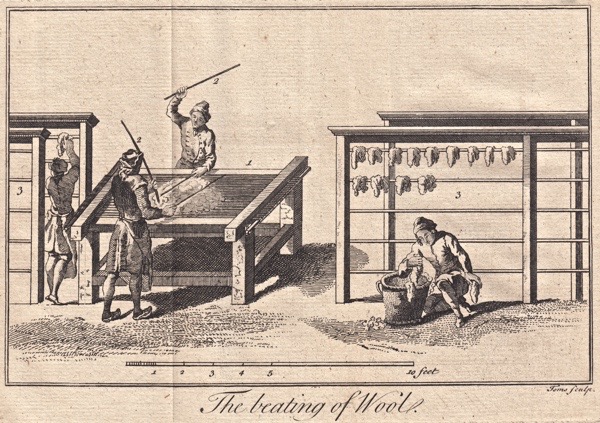The Principal Operations of Weaving, 1748
Read my feature about Dennis Severs’ House with twelve pages of photographs by Antony Crolla in the March issue of World Of Interiors out now.
These copperplate engravings published below illustrate The Principal Operations of Weaving reproduced from a book of 1748 in the collection at Dennis Severs’ House. As you will discover, there was far more to weaving than sitting at a loom and many of these activities would have been a familiar sight in Spitalfields three centuries ago.







Ribbon Weaving











Dennis Severs House, 18 Folgate House, Spitalfields, E1
Click here to book for DENNIS SEVERS’ TOUR devised by The Gentlle Author
You make also like to read about















These are fascinating and show just how complicated the whole process of weaving was and how many different skills were involved. And how back breaking some of the processes look…
My first experience of weaving was when I made my own very simple loom aged about 8 and I can remember the excitement of seeing the finished ‘cloth’ evolve (it was only about 3″ wide!)
I also did some weaving as part of my art foundation course but again it was on a very simple loom – nothing at all like the amazing machines in the above pictures.
Thank you for showing these looms and the link to Dennis Severs House. They take up quite some space inside and I can’t imagine them fitting in the small houses with tiny backyards that my grandma lived in Raven Row behind the London Hospital The machines and their operation are wonderful examples of 18 th Century technology.
Weaving was the backdrop to Silas Marner perhaps the greatest novel of the 19th century and it shows how important and widespread an industry weaving was . Although George Eliot’s novel wasn’t set in London there must be so many untold stories of the weavers of Spitalfields .
Looking forward to your article in World of Interiors magazine. The magazine is my annual gift to myself, and I go into a tailspin if an issue is delayed, or my subscription gets scrambled. (alas, it happens………) With their history of showing eccentric and unique properties, I’m surprised it has taken them so long to get around to the Dennis Severs House — but am thrilled by the prospect.
WOI + Dennis Severs + GA = Brilliance!
As an O-level student, during the examination I answered a question which asked me to ‘Illustrate my answer’, which I did, but failed to write any text. Needless to say, it earned me no points.
Now, ‘These copperplate engravings published below illustrate The Principal Operations of Weaving reproduced from a book of 1748’… May we assume correctly that the book only contains engravings?
The Stroudwater Textile Trust is being sent the link to to this page of beautiful engravings!
My family were hearth rug weavers in Hoxton, and I discovered that their beautiful iron-framed hand loom dating from 1832 is crated up in the Science Museum’s reserve collection in Swindon. They closed down in 1940 – the last hearth rug weavers to do so, having woven rugs for Queen Victoria’s Coronation in 1838 and the House of Commons .
Sincere thanks to all the Museum and Library archivists who tirelessly help individuals to discover wonderful things about their family history.
Thanks, GA! No wonder so many bequests in the old wills I’m transcribing gave clothing to relatives! It had to be costly when it came from the arduous hand labor shown in your pictures, and pieces were hand stitched together with needle and thread. The picture of the shear man at work fascinated me because an ancestor at Sheffield, baptised in 1691, was apprenticed and became a shearsmith. Would love to see more detailed pictures of the shears and how exactly they were used.